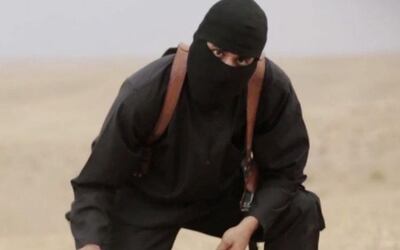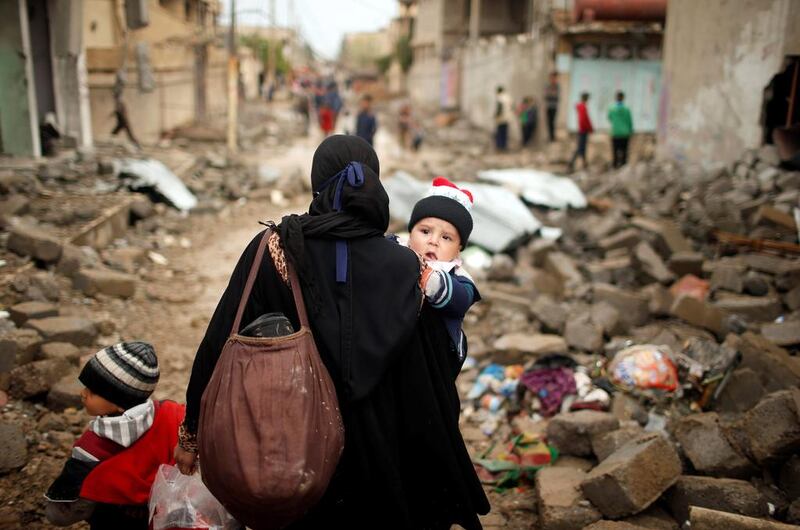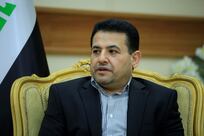This year is ending on a high note for the battle against extremism in two key countries in the region. In Iraq and Syria, the campaign to topple the so-called caliphate project that ISIL established in June 2014 has largely achieved its objective. After three-and-a-half years, the international coalition dislodged the organisation from at least 98 per cent of the territory it once seized.
In practical terms, this means the world no longer faces a threat on the same scale. The momentum that had enabled the organisation to attract thousands of foreign fighters and their families is disrupted. The group’s ability to expand and threaten other countries is seriously reduced. Countries like Iraq and Syria, which once feared the ramifications of an advancing militant group, now have a breathing space to focus elsewhere.
ISIL is currently under enormous strain. The group is in its weakest state since the summer of 2014, in terms of manpower, finance and ability to attack or defend itself from attacks. As a result, its ideology and appeal have also been undermined. Those who have seen first-hand the group for what it is, a ruthless militant organisation that was as vicious towards Sunnis — the demographic it claimed to represent — as it was against others and arguably even more, as evidenced by the massacres of people such as the Shaytat tribe in Deir Ezzor, eastern Syria.
Those gains against ISIL present an opportunity not only to kill the organisation but to prevent its resurrection. To ensure that happens, the process hinges on recognising a simple fact: the United States and its partners have won the war that began in the summer of 2014, but have not won the war that began earlier.
A key aspect of this long-running war is the notion of keeping the states in which jihadis operate weak and unable to govern, or at least not govern the whole of a country. ISIL has had a stated strategy for this aspect of the war for more than a decade, with demonstrable results in 2014. ISIL calls the war in which it is engaged the "long war", as Americans and others often do . And a major focus for ISIL is to fuel this long war but with a clear objective, namely that its enemies in the West and in the region become ever less willing to do what it takes to truly win the war.
Unless this aspect of the war is acknowledged, western-backed forces might keep "winning" the same war countless times. Yet as they pat themselves on the back, societies suffer, towns face multiple destructions and the problem of extremism becomes wider and deeper — as we have seen since the war on terror began 16 years ago. The outcome of that includes a larger Al Qaeda as well as new threats created in the war’s aftermath, ranging from ISIL to other nascent regional and global jihadi organisations from both Sunni and Shia inclinations.
___________
Read more:
[ Iraq year in review: the country may be free of ISIL but lies in ruins ]
Year in review: Russia strengthens bid for Middle East influence
[ The liberation of Mosul: Victory at a price ]
____________
Fortunately for those seeking to defeat ISIL, they have enough to go on to tell them how. After all, the US and its allies have been fighting the same group for more than a decade; presumably they have come to know its history and nature. More importantly, ISIL itself has extensively discussed critical periods of its existence and how it bounced back before from even more thorough defeat.
It has been through weak phases before, under various circumstances, so it is possible to assess from those where the group is heading next.
In the first period, pinpointed by ISIL itself as early 2008 to late 2009 in Iraq, the group had suffered an almost total defeat. ISIL speaks about this phase of its existence in a defining document that is more timely at this point than at any time over the past three years. The document discusses similar circumstances to those it is facing today, and thus merits a close look.
In “The Strategic Plan for the Consolidation of the Political Standing of the Islamic State of Iraq”, finalised in December 2009 in Fallujah, Iraq, ISIL offers its own diagnosis of what went wrong for it after it had failed to control Sunni areas in Iraq and unify the insurgents under its ranks.
The document makes it clear that the popular uprising against it in Sunni areas, with American help, was overwhelming and devastating. It discusses how tribesmen turned against the militants as part of a tribal solidarity and does not shy away from acknowledging that the uprising was inclusive of all tribes, starting from the town of Husaybah near the Syrian border, with the Kataib Al Hamra insurgent group, to the rest of Iraq.

Around the time the document was being drafted, ISIL began to see the reversal of the momentum that had led to its demise, referring again to tribal dynamics as a factor for the change. Unlike even shrewd analysts of the conflict at the time, ISIL saw emerging signs of new opportunities. Young people who had joined the Awakening Councils, as the American-backed Sunni units were called, began to be disillusioned with their leaders. Tribal elders became restless about the rise of new overlords from within their tribes. The Councils began to gradually crumble, and the group began to gain renewed, if quiet, relevance.
The purpose of the 55-page treatise was to "plan and prepare" for the departure of American forces in 2011. ISIL's war minister at the time, Abu Hamza Al Muhajir is quoted as saying that other parties in Iraq were preparing for the troops' withdrawal two years later. "They shoot one rocket and store ten others."
The preparation phase, as outlined in the document, involves various tactics to enable the group to consolidate itself within Iraq and abrade the capabilities of its rivals. The group would focus on preventing the emergence of local structures able to fill the vacuum after the withdrawal. Such tactics included the targeting of police and army units, to “maximise the cost” of joining their cadres.
This war of attrition would take years, during which the group would focus on former allies who had turned against them and would therefore be competitors for popular legitimacy in Sunni areas. Over the years, ISIL has succeeded in eliminating or absorbing its former rivals in Iraq, and that may play out in its favour as it embarks on a similar phase of attrition.
“After our emancipation from the circumstances around the Sahwat (Awakening Councils) and with the end of that phase, in which the Sahwat presented a real danger to the dawlah (ISIL),” the document stated, “this period emerges as a period of planning and preparation for what comes after the American withdrawal … the real victor of this battle will be the one who knows how to plan and prepare for the post-withdrawal period.”
The authors of the Strategic Plan then argue against allies who regard the goal of an Islamic state as unrealistic. It is in this section that another theme becomes clearer as the extremists proclaimed an Islamic state in 201 — namely the state of savagery.
They cite Ibn Khaldoun, the 14th-century Arab sociologist, saying, "Savage nations are better able to achieve superiority than others … savage groups are braver than others. They are, therefore, better able to achieve superiority and to take away the things that are in the hands of other nations.”
In 2014, two sources from inside ISIL revealed that the Management of Savagery, a 2004 jihadi book attributed to an Egyptian militant by the name of Mohammed al-Hakayma, was being read by the group. The claim was later confirmed by another insider source.
One of the book’s themes is that major victories in history, specifically naming the Muslim battle of Hattin against the crusaders, came about because of minor battles that preceded them. Attacks against enemy convoys or castles by small bands of fighters as part of a ceaseless and depleting insurgency made the final outcome more possible. By the time ISIL emerged again, its former enemies would be much weaker and the power vacuum would allow the capture of large swathes of Iraq and Syria.
After the rise of ISIL in 2014, politicians in Washington and elsewhere recognised those conditions and tried to address them first by replacing former prime minister, Nouri Al Maliki.
Sensible observers should have a sense of history. What politicians and media celebrate about the demise of ISIL was celebrated before. In 2010, the group was said to have fallen apart, its ability to conduct attacks was crippled and its ideology was undermined by its vicious tactics.
ISIL was defeated again between the spring of 2013 and the summer of 2014, and this time by the very people it claimed to represent: Syrians who rose up against the regime of Bashar Al Assad. After Abu Bakr Al Baghdadi was rejected by the man he sent to establish a Syria chapter, the group was expelled from most of Syria. It was dislodged from Idlib and the city of Aleppo, never to return. It was also expelled from most of Raqqa, Deir Ezzor and Hasaka.
By May 2014, the group appeared on the back-foot after four months of warring against various rebel groups. More critically, that period was when ISIL was most bruised ideologically. It was then that the group was attacked for its ultra-extremist, vicious and illegitimate ideology. The name "Daesh", the pejorative Arabic name for it, was given to it by Syrians. Supporters of the Syrian rebellion also issued fatwas describing the group as "khawarij", drawing on the name of an extremist movement that emerged in early Islamic history, which declared Muslims at the time as apostates in the same way that ISIL did.
So, the group had already been undermined before the world felt the shock waves of the rise of ISIL in June 2014. The outside world came at least six months late to the show, and under American leadership hijacked the real war that could have properly ended the group.
The same disconnect persists today. The same things are being said — that ISIL's ideology is undermined, that people have seen the group for what it is.
Those statements are true, but those accomplishments are not enough on their own to draw final conclusions. The war against the group has only taken a new shape and the underlying problems have become far more compound. The profound misery, profound hatred and profound illusions will ensure new monsters will emerge, regardless of what names or forms they will have.





